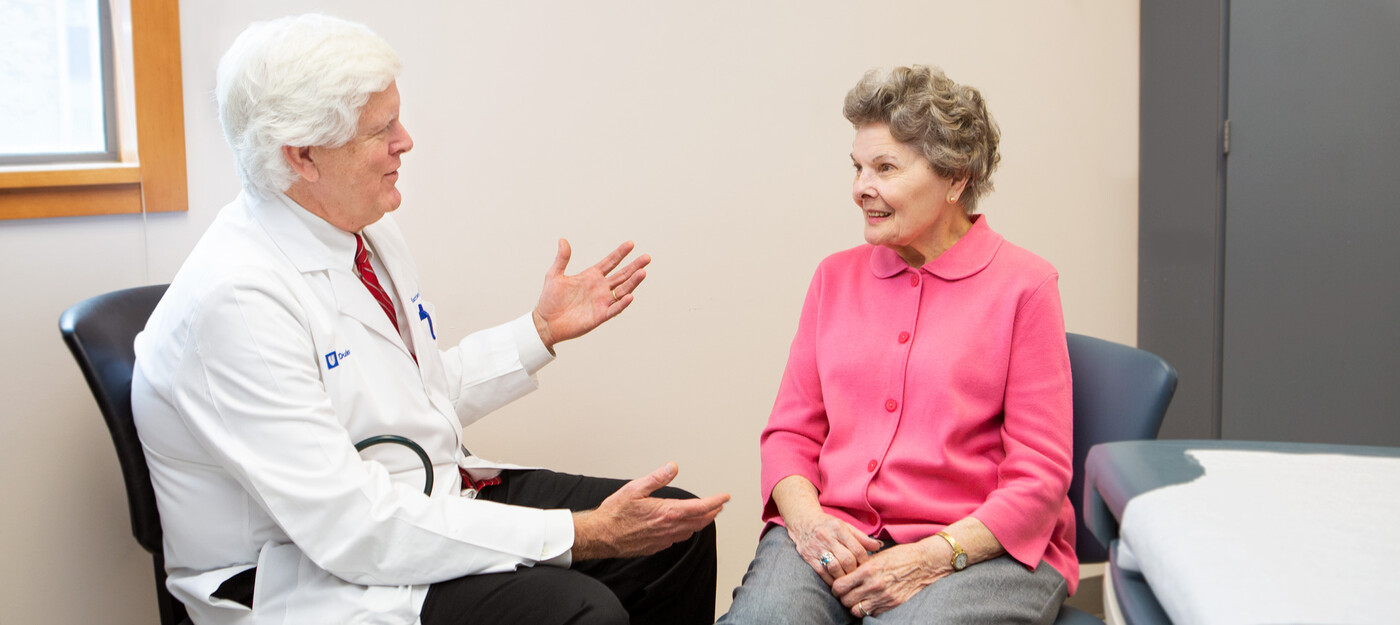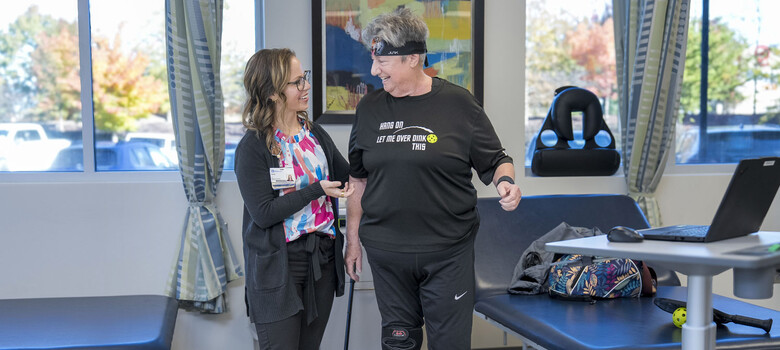 From the DukeHealth.org archives. Content may be out of date.
From the DukeHealth.org archives. Content may be out of date.
Considering Transcatheter Aortic Valve Replacement?
Questions to Ask Your Doctor About TAVR

J. Kevin Harrison, MD, talks with Bettie Robinson, who recently had a TAVR procedure.
Many doctors and hospitals now offer transcatheter aortic valve replacement for aortic valve disease, but their experience and success rates vary. Here’s what you need to know before choosing where to have TAVR.
About TAVR
If you have aortic valve disease and your age or medical condition raises your risk with open-heart surgery, you may be a candidate for TAVR, also known as transcatheter aortic valve implantation, or TAVI. Even if you have standard risk with open-heart surgery, you may be a candidate for TAVR at Duke as part of one of our clinical trials.
In TAVR, the doctor inserts a flexible tube called a catheter into a small incision -- usually in your groin -- and uses it to guide a replacement valve into position inside your diseased aortic valve. Avoiding the larger incisions of open-heart surgery and the need for the heart-lung machine means you spend less time in the hospital, have less pain, and recover more quickly.
If you’re considering TAVR, Kevin Harrison, MD, co-director of Duke’s TAVR program, recommends asking these questions before deciding where to have the procedure.
Important Questions to Ask
How much experience do you have with TAVR?
Research shows a link between the number of procedures performed and successful patient outcomes. Duke University Hospital has been offering TAVR procedures since 2011 and was a leader in the pivotal clinical studies that led to FDA approval of TAVR in the U.S. To date, Duke doctors have performed more than 1,000 TAVR procedures, 231 of them in 2017 alone. By contrast, many hospitals started their TAVR programs recently, and their teams may not have as much training or experience in treating patients with catheter-based valves.
What’s my chance of surviving TAVR?
As with any heart procedure, there are life-threatening risks, so survival rate is a critical measure. At Duke, our TAVR survival rate is 98.7%*.
What are my risks of complications?
Complications of TAVR may include bleeding, kidney injury, heart attack, and stroke. Duke’s complication rate for TAVR procedures is below the U.S. average*.
How well will my new aortic valve function?
Sometimes, a new TAVR valve may not seal completely within your old valve. This allows some blood to leak back around the new valve (called aortic regurgitation), which makes your heart work harder. Moderate aortic regurgitation rates were 0% for Duke patients in the calendar year 2017*.

At Duke, we have access to and experience with all of the most current and advanced valves.
How will you get the new valve to my heart?
How your doctor gets the valve catheter to your heart makes a difference in your recovery. Duke doctors strive to place the catheter through a blood vessel, most commonly in your groin (the “transfemoral approach”), rather than making an incision in your chest (“transapical access”). In transapical TAVR, the doctor usually makes an incision between the ribs in the left chest and puts the catheter directly through the heart muscle. Recovery following this procedure is more difficult, and survival rates are lower than for transfemoral TAVR. In 2017, 0% of Duke TAVR patients required chest incision*.
What valves do you have available? How will you decide which is best for me?
This is important because the approved TAVR valves don’t work for every patient. Centers that don’t have access to all available valves may not be able to treat everyone who can benefit. At Duke, we have access to and experience with all of the most current and advanced valves. Our team of heart surgeons, interventional cardiologists, and heart imaging experts meets weekly to review each patient, their test results, and their medical images in order to determine the best treatment option for each individual.
How long will I be in the hospital after my TAVR procedure?
Typically, Duke patients leave the hospital within two days following a TAVR procedure.
How will you coordinate my care?
We communicate with your primary care doctor before and after your procedure to ensure you have continuity of care. The majority of your medical care can be provided by your local doctor. If you’re coming to Duke from out of town, we can coordinate your appointments so you’ll have imaging, diagnostic tests, and doctor consultations all in one day. Typically, the process involves one or two visits before your procedure plus two follow-up visits -- one at two weeks after your procedure and one at the one-year point following your TAVR procedure.
* Source: STS/ACC TVT RegistryTM 2017 Q4 data. The registry is a collaboration between the Society of Thoracic Surgeons and the American College of Cardiology to monitor patient safety and outcomes in transcatheter heart valve procedures.








